WORLD CLASS COACHING
The Complete Guide to Passing and Possession
By Jebreel Bubtana
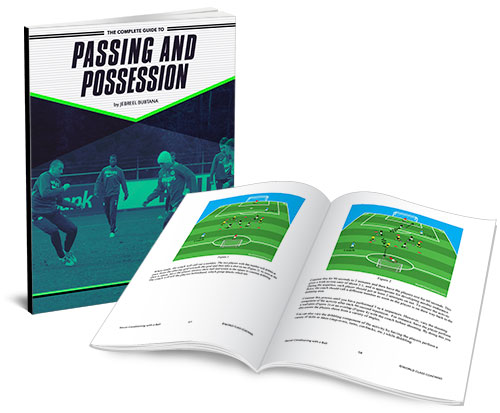
TABLE OF CONTENTS
Part Three
DIRECTIONAL POSSESSION EXERCISES
Directional Possession Exercises
2v2 with Outside Neutrals
This exercise is a good progression for the “Passing technical warm up” exercise earlier, adding pressure and direction to the exercise.
It is 2v2 in the middle of the square and four neutrals on the outside of the square.

Initially all four neutrals can be used by the players in the middle to help them keep possession. The teams in the middle get a point for every 5 passes, which include passes to the players on the outside.

Progression:
The players in the middle are now only able to use the two players on the outside of the same color to help them keep possession. Again, every 5 passes count as a point.

Progression:
The exercise is the same but now if the space opens up for the outside player to pass straight across to the other outside player on their team then they can do so. The players in the middle must react to this and offer passing options quickly as the ball is moving across.
Coaching Points:
• Weight and accuracy of pass into the correct foot depending on pressure
• Speed of movement to support player on the ball (read the body language of the player passing the ball and move quickly to support teammate)
• Open body position to see as much of the field as possible and receive on the back foot
• Make sure that the player has checked their shoulder to see where the space is before receiving the pass
• Communication
Switch the Point of Attack Small-Sided Game (across the river)
Switching the point of attack quickly is a very important part of the game in order to exploit space to put the opposition defence under pressure.
Set up the field as shown below with 4 players in both outside thirds who will be working together along with two players in the middle third. The numbers and size of the thirds can be adjusted depending on how many players you have, their age and their ability. Four defenders will also be in the middle area. Make sure that there are plenty of extra balls with the coach to keep the tempo of the game high when the ball goes out of play.

The ball will start in one of the outside thirds and two defenders will go in to pressure the ball. Every time the ball is switched from one side to the other, the attacking team gets a point. The defending team gets a point by winning the ball. When switching the ball across to the other side of the field, the ball must pass through one of the two attacking players in the middle area who act as central midfielders. Initially, the defenders in the middle can’t pressure the attacking players. When the ball is switched, two new defenders go in to pressure the ball and the previous defenders return to the middle area.

Make sure that the players are being switched every few minutes. When the ball goes out of play or the defenders win the ball, take a ball and pass across to the other side of the field in order to keep the exercise flowing.
Progression:
The defenders left in the middle can now pressure the attacking players in the middle. The attackers can also choose to bypass the players in the middle if they are not in an open position and just pass all the way across to their teammates on the other side of the area. This means that those central midfielders must work to create space to receive the ball. The central midfielders can also pass back to the same area if they are under pressure and it is not appropriate to switch the point of attack, bringing in the type of decision-making they would need to make in a match situation.
Coaching Points:
• Weight and accuracy of pass into the correct foot depending on pressure
• Speed of movement to support player on the ball (read the body language of the player passing the ball and move quickly to support teammate)
• Open body position to see as much of the field as possible and receive on the back foot, especially the central midfielders
• Make sure that the player has checked their shoulder to see where the space is before receiving the pass
• Communication
3v3 (plus 2) to Target Players and Neutrals to Teach Playing Out of the Back
Increasingly over the years, the role of the goalkeeper and defenders in possession has gone from them getting rid of the ball as quickly as possible to the need for them to be comfortable in possession. The exercise below is great for developing this ability and confidence on the ball in a small setting.
The exercise is 3v3, with a target player either end of the area and two neutrals on either side. The neutral players on the side will act as full backs when either team is in possession. Adjust the size of the area depending on the age and ability of the players.

The 3 in the middle will set up their triangle with two in the back to act as central defenders and one player in front of them who will act as a deep lying midfielder. The aim of the game is for the players in the middle to get the ball to the target players for a point. When they have scored, they are rewarded by receiving the ball back but now having to attack the opposite end, though they can go back to the target player they just used to score if they are under pressure but it won’t count as a point until they have tried to attack the other end.

The main point of emphasis is the shape of the players. When the target player has the ball, they act as a goalkeeper and pass the ball into either central defender who will have split to the width of the area. The full backs/neutrals on the side will move higher up their line and the central midfielder will offer an option through the middle. If one of the central defenders receives the ball, the central midfielder will check in to offer a passing option, whilst keeping their body shape open.
Initially, I would allow the defending team to drop back slightly so that the attacking team can get into the correct shape and also allow either central defender to receive the first pass before being pressured in order to build a confidence and familiarity with what movements are required of the players first.
Progression:
You can allow the players defending players to press whenever they want and also allow the target player/goalkeeper to pass the ball to any player they want to so now they have some more decision-making opportunities.
Progression:
Both teams will now have one direction to attack.
Coaching Points:
• Weight and accuracy of pass into the correct foot depending on pressure
• Ensure that the team in possession gets into position quickly to give the target player/goalkeeper quick options to play out from the back
• Open body position to see as much of the field as possible and receive on the back foot
• Make sure that the player has checked their shoulder to see where the space is before receiving the pass
• Communication
3v3 with Target Players to Coach the Three Midfielders in a 1-4-3-3
The 1-4-3-3 has become a very popular formation recently, with many teams across the world adopting it. The exercise below is very simple and can be adapted depending on whether you play your midfield 3 with a point up or point down.
Set up the field as shown below with 3v3 in the middle and two target players on either end of the area. The 3 in the middle will set up as they would do in a 1-4-3-3 with a number 6, 8 and 10. The size of this area can be adapted depending on the age and ability of your players.

The teams score by passing into either target player and the reward for scoring is that the team receives the ball back to attack in the opposite direction. After scoring, the team in possession can go back to the target player they just used to score if they are under pressure but it won’t count as a point until they have tried to attack the other end. It is important that in possession, the 3 players are not in the same line as each other both vertically and horizontally, which will help to create angles to receive the ball.
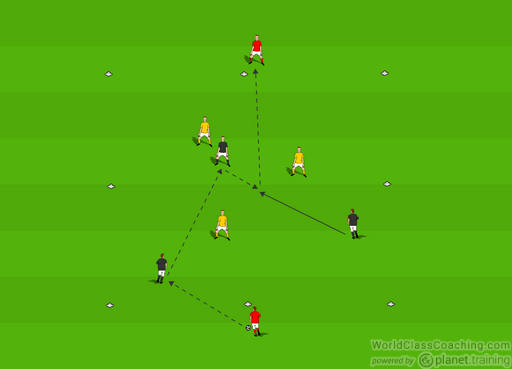
As shown above, the number 6 will come short to receive the ball, the number 10 will create depth by being the furthest passing option in yellow and the number 8 will find space a little further forward than the number 6 to provide an angle and passing option forward. This would be when playing with one holding central midfielder. It is important for the holding central midfielder to remember that if they are not able to pass forward, that they can pass back to the feeder (or central defender in a match) in order to keep the ball. You can also encourage the rotation of positions as the game is going on, which may help to create space to receive the ball.
Progression:
The teams can now only attack one way, but they can still pass back to help keep possession.
Coaching Points:
• Weight and accuracy of pass into the correct foot depending on pressure
• Ensure that the team in possession gets into position quickly to give the target player passing options
• Make sure that the 3 players do not play in the same line as each other either vertically or horizontally
• When in possession the 3 midfielders need to use as much space as possible by creating depth and width with their movement (essentially a big triangle)
• Open body position to see as much of the field as possible and receive on the back foot
• As well as checking their shoulder, the players should be encouraged to look forward to see if there is a passing option in that direction as it is important for the players to realize that if they can pass forward then they should do so quickly to exploit the space and score rather than going sideways or backwards
• Communication
4v4 to Wide Goals
The exercise below is a great way to encourage switching the point of attack and, as mentioned previously, is a very important part of possession soccer.
Ensure that the area is wider than it is long and place 4 mini goals in the corners of the area. Each team will set up in a diamond shape, with two players out wide, one further forward and one player who supports the play from behind.
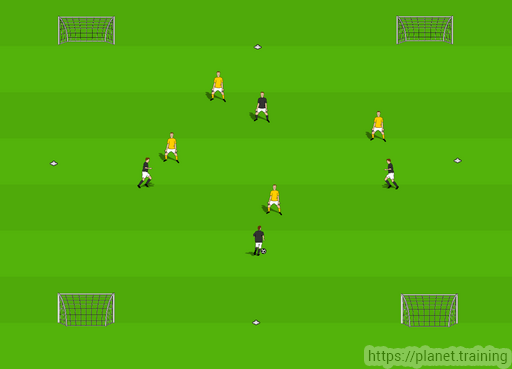
Each team will have two goals they can score in, with one team attacking the two goals at the top of the picture below and the other attacking the two goals at the bottom.
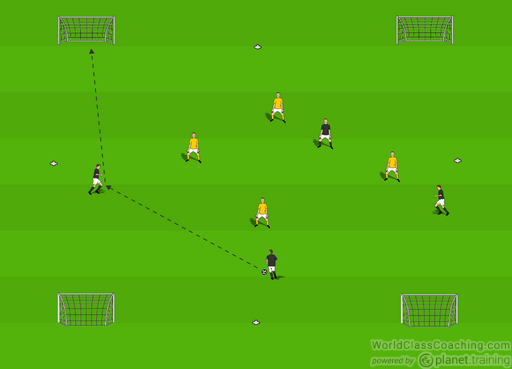
Coaching Points:
• Weight and accuracy of pass into the correct foot depending on pressure
• When the team is in possession, make sure the players create width and depth to stretch the opponents
• When the ball is lost, encourage the 4 players to work together to pressure the ball quickly and be compact
• Remind the players that if they can’t attack one goal that they should switch the point of attack and try to score in the other goal
• The player at the back of the diamond needs to always offer the option to pass back to them in order to help switch the point of attack
• Encourage the rotation of positions as they game is going on as this may help to create space to receive the ball
• Open body position to see as much of the field as possible and receive on the back foot
• Make sure that the player has checked their shoulder to see where the space is before receiving the pass
• Communication
Receiving Under Pressure Game
This small-sided game will work on your player’s ability to receive the ball under pressure.
Set up the 6v6 game as shown below, using the appropriate size field for the ability and age of your group. The field will include a square in the middle that one designated player from each team will be in.
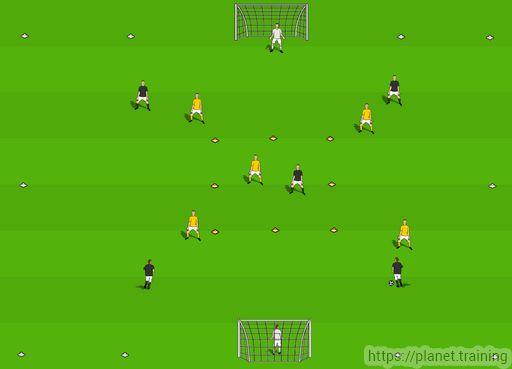
It will be a regular 6v6 game but before a team is able to score, they must use their player in the middle square in every possession.
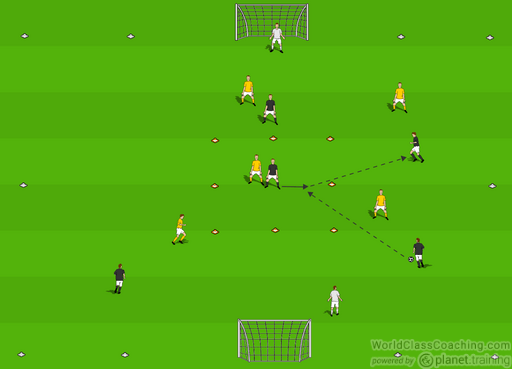
Progression:
Now both teams can score without using the middle player but if they are used and a goal is scored, the goal counts as double.
Coaching Points:
• Weight and accuracy of pass into the correct foot depending on pressure
• Quick and sharp movement to create space away from an opposing player and to create passing options
• When the team is in possession, make sure the players create width and depth to stretch the opponents
• Open body position to receive the ball on the back foot
• Decision making, especially in the progression in terms of when to use the player in the middle and when not to
Crossing and Finishing and Possession Game
Set up the field as shown below with a wide zone on both sides of the field, with one player from each team in a wide zone (signified by the shaded area below but cones can be used to set up the two zones).
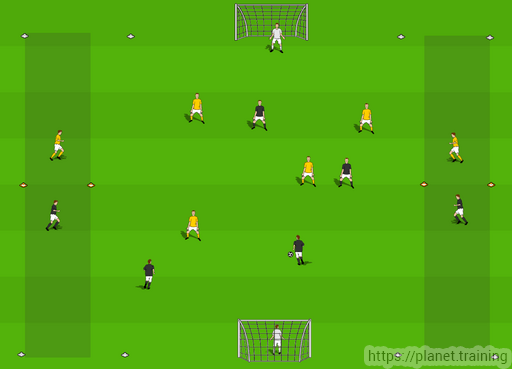
In order to add an element of decision making, a goal can be scored with or without using the wide players. If the wide player does receive it then they can’t be challenged by any other player. As shown in the diagram below, each zone will also be split into two, with different roles depending on which zone the wide player receives the ball in. If they receive the ball in the zone closer to their goal then their aim is to help their team keep possession, but if they receive in the zone closer to the opposition goal then their aim is to cross the ball in for one of their team mates to score. This is in order to try and reflect real game situations. For example, if a wide player were to receive the ball in the final third then they would look to attack, whereas if they were to receive the ball deeper, then they would most likely look to help their team keep possession of the ball.
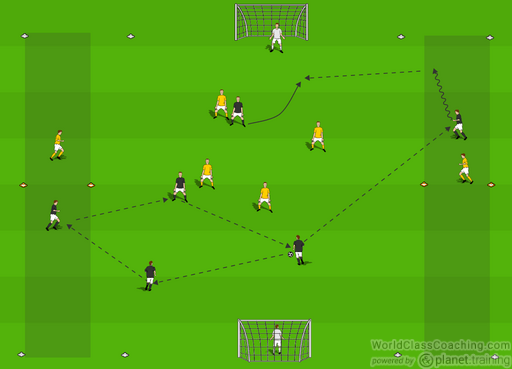
Progression:
Allow the opposing wide player to challenge the wide player in their zone.
Progression:
Take away the wide zones but encourage the players to keep utilizing the width of the field.
Coaching Points:
• Weight and accuracy of pass into the correct foot depending on pressure
• Decision-making in terms of when to play through the middle and when to use the wide players
• Open body position to receive the ball on the back foot
• Quick movement to support the player in possession
• Particularly in the last progression, make sure the players understand that when they are in possession to create width and depth and when they are out of possession to be compact
• When the wide player receives the ball in the attacking part of the wide area, then they need to get their head up quickly to see the runs of their teammates
Shooting and Possession Game
The exercise below focuses on keeping possession with the intent of creating a shooting opportunity as quickly as possible.
Split your group into two teams, including a goalkeeper in each goal and make sure there is a half way line in the area that is clearly visible to the players.
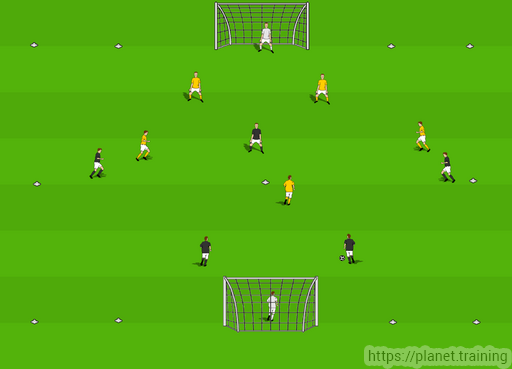
Both teams try to keep possession of the ball and when the opportunity arises, they can shoot on goal. However, they can only shoot from their own half.
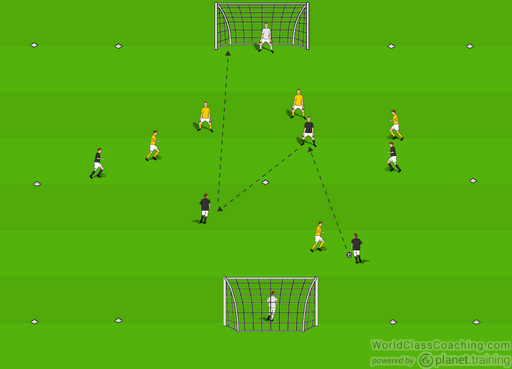
Encourage the players to be patient in their build up play and to use their goalkeeper to work the space for a shot on goal.
Progression:
Limit the maximum number of touches that the players can have, for example, 2 or 3 touch.
Coaching Points:
• Weight and accuracy of pass into the correct foot depending on pressure
• When a team is in possession, make sure the players utilize the width of the field to stretch the opponents
• When the ball is lost, encourage the players to work together to pressure the ball quickly and be compact
• Encourage the players to take chances and be creative
• Open body position to receive the ball on the back foot
• Make sure that the player has checked their shoulder to see where the space is before receiving the pass
• Decision-making of when to possess and when to shoot
• Move the ball at a high tempo to take advantage of the space that opens up
• Use the goalkeeper to help keep possession
• Communication
• Correct shooting technique and keeping the head down to keep the ball low and on target


